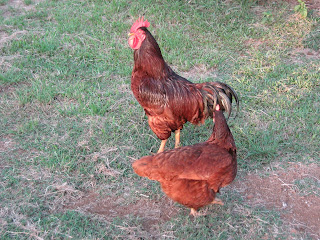 |
| Ivan the Red and his favourite wife, Griselda. |
Last year I saw a goshawk come in low over the flock, looking for a bird small enough to carry off. Ivan, the rooster, gave a low warning cry to the hens- It sounds like a growl, before launching himself into the air after the hawk. Now chickens are not spectacular fliers in anybodies book and poor Ivan only made it perhaps ten metres into the air but it sure scared the hell out of the goshawk. Ivan must have looked like a red faced feathered cannonball fired from the ground and the goshawk took off at a great rate of knots indeed. Ivan was absolutely convinced he had given the intruder a right seeing to and proceeded to strut about the yard like, well, like a cock-of-the-walk for days afterwards. All the admiring lady hens certainly helped too. Ego is important to a rooster.
 |
| Hens lounging in the warm sun while Ivan keeps watch |
While I like to hatch chicks naturally whenever possible we do also use an incubator when we need more chicks and no hen is obliging by going broody. Broodiness is bred out of laying hens for the most part because when a hen goes broody she also ceases laying. Not desirable in a laying hen. One solution is to keep a few hens of a breed that will go broody on a regular basis. My choice for this is the Pekin Bantam which in my experience make mothers par excellence. I intend to add a few to my flock as soon as opportunity presents itself. I use the bantam as it is easy to tell the eggs apart from full sized birds and thus prevent hatching out crossbreed chicks.
The incubator we use is a Hovabator. Since taking the photo above I have added an automatic egg turner, a fan and electric thermostat. A lot of money to compete with a chicken!
But when it works, the results are worth it. You will notice the two black chicks in the photo above. These are australorpe crossbreeds and are fine meat birds. Half of the birds hatched will of course be cockerels and these also make fine meat birds. I raise these on a mix of mixed grain, cracked corn, mill run, some greens and the excess milk from the cow. At ten to fifteen weeks we slaughter them for delicious organic chicken. This actually tastes like chicken and is a far cry from the insipid chemically raised victims you can buy at the supermarket.
Just as I have written the above, the first of some guinea fowl eggs I was given recently, has hatched in the incubator next to me. I am quite pleased as I have had no success in getting our guinea fowl to breed so far. Don't get me wrong, they certainly try each year. The two females will sit huge clutches of eggs in a hidden nest out in the field somewhere but they always fail to hatch.
I like guinea fowl, they are completely mad. Despite this they are also excellent insect eaters in the veggie garden and at the same time they wont do any harm to the plants. Guinea fowl are also reputed to keep snakes away and eat cattle ticks. I don't know if they actually do all of this as mine did not come with the manual but I like them anyway.



No comments:
Post a Comment